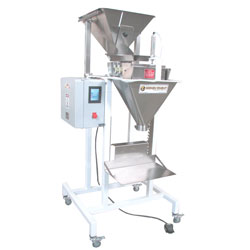An Overview of Linear Bucket Scales
Weighing Solutions for Your Production Line
Linear bucket scales accurately weigh items by discharging a product from its buckets once it reaches the desired weight. These scales can use multiple or single-weigh buckets to measure a product.
In this guide on linear bucket scales, we are going to cover
- How a Linear Bucket Scale Works
- Types of Linear Bucket Scales
- Types of Gates
- Upstream Equipment
- Downstream Equipment
- Manufacturers
- Engineering Questions

Photo Source: Weigh Right
How a Linear Bucket Scale Works
A product begins the weighing process by first entering the supply hopper and then is distributed down into the feeding tray. With the help of vibrations and movement, the product is moved along the tray and dumped into the front bucket. Once the weigh bucket has reached its desired weight, the product is emptied through the discharge hopper and ready to move on to the next stage of packaging.
Types of Linear Bucket Scales
Semi-automatic - This requires the operator to use a foot pedal as the product gets placed in the weigh bucket. The bucket will stop vibrating and then the operator can press the foot pedal to dispense the product into the container.
Automatic - When running an automatic linear bucket scale, the product needs to be taken from ground level to the top of the hopper. You can see in the video example below, our engineering services team achieved this by using a Z-bucket conveyor so that the product can be dispensed into the cleats. The product then goes up the incline and then is discharged at the top. From there, it is now ready to be dispensed into the bucket scale and move onto the conveyor after being weighed.
Types of Gates
Two types of gates are slide and dribble gates. They can help with weighing products by stopping the product from being dispensed into the bucket after the desired weight has been met. These are typically seen in the food industry, including coffee and confectionery productions.
Upstream Equipment
Types of equipment that are recommended for upstream are,
- Supply hopper
- Vibratory feeder
- Bucket Conveyor
-Gravity metal detector
Downstream Equipment
Some recommended downstream equipment are as follows,
- Pre-made pouch machine
- VFFS
- Bag sealer
Manufacturers
SIGMA sells a wide variety of scales made by various OEMs, but the ones we most commonly work with are
- WeighPack
- Ohlson
- Weigh Right
Engineering Questions
Some questions to ask before purchasing a linear bucket scale are,
- How many weighs per minute can the machine perform?
- What is the width of the feeder panel?
- How does the product feed?
- How many lanes does it have?
- What is the minimum and maximum weight capacity they can do?
- What is the weight accuracy?
- What is the supply hopper capacity?
- What type of coating is on the feeder?
- Is the unit capable of a wash down?
- Does it have supply hopper?
- Is it textured metal?
- Does it have a dust hood to collect dust when product is moving down the scale?
- What kind of gates does it have?
Summary
Linear bucket seals are versatile pieces of equipment that will help your production line weigh products accurately. They can be purchased as semi-automatic or can be fully integrated into an automated line.
If you’re working on a project that requires exact measurements and are looking to buy a linear bucket scale, you can get in touch with a member of our sales team by clicking the button below.
Contact

